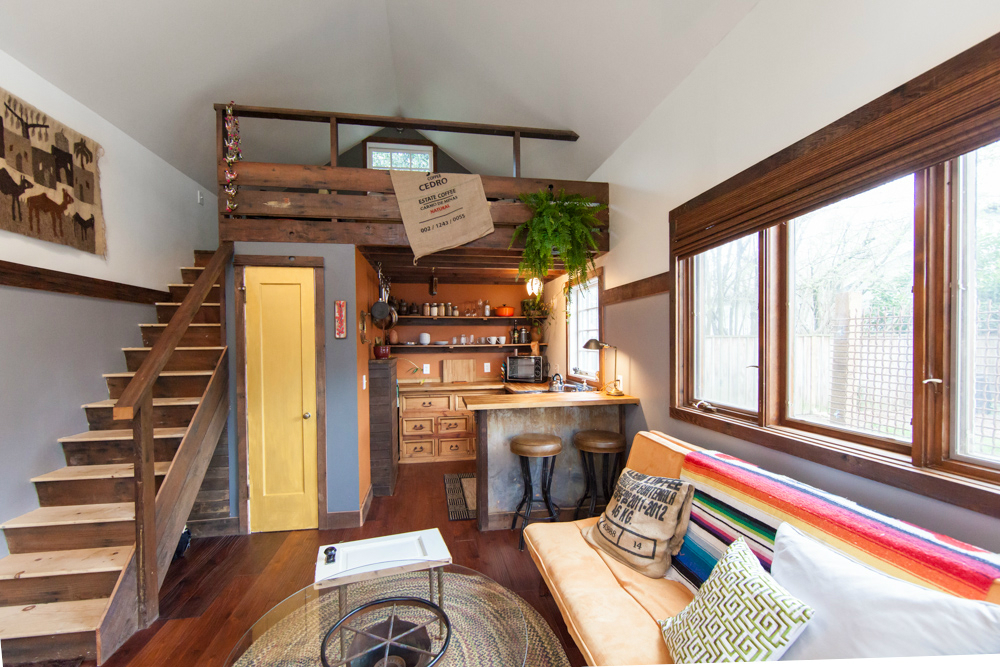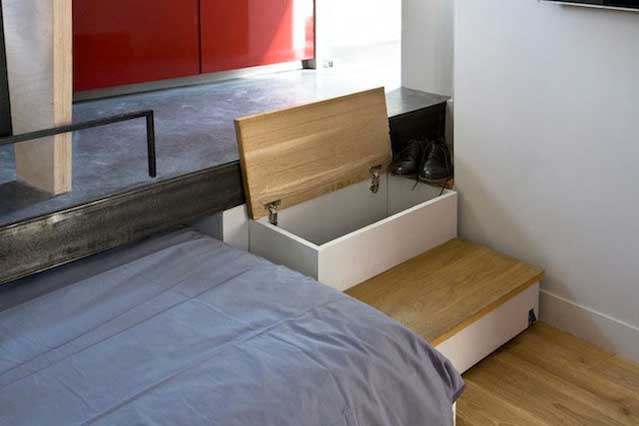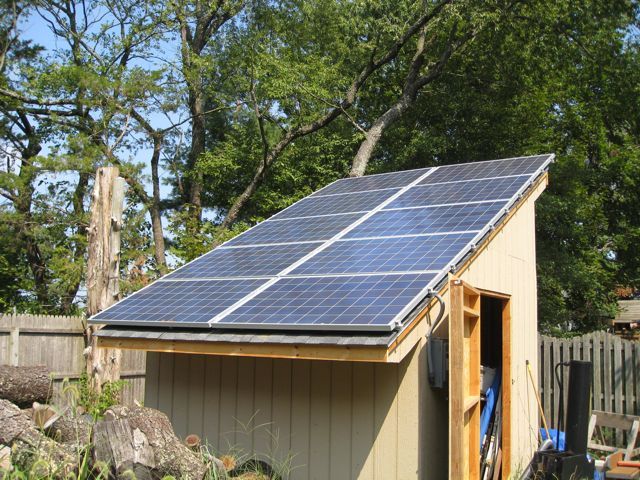As you embark on designing the interior of your tiny home, it’s essential to keep an off-grid lifestyle in mind.
By incorporating sustainable materials, efficient appliances, and creative storage solutions, you can create a space that not only reduces your carbon footprint but also enhances your overall well-being.
From using natural light to its fullest potential to implementing eco-friendly decor choices, every aspect of your tiny home’s interior design should be intentionally designed with the off-grid lifestyle in mind.
By doing so, you’ll not only save money on energy costs but also contribute to a healthier environment for yourself and future generations.
Let’s dive into some actionable tips on how to achieve this vision for your tiny home interior design.
Optimize natural lighting
Incorporate large windows and skylights to maximize natural light and reduce the need for artificial lighting. This not only saves energy but also creates a brighter and more inviting space.
By incorporating large windows and skylights, you can maximize the amount of natural light that enters your home or office, reducing the need for artificial lighting.
This not only saves energy and money on your electricity bill, but it also creates a more welcoming and uplifting environment.
Studies have shown that exposure to natural light can boost productivity, improve mood, and even enhance cognitive function.
In addition, natural light can help to reduce eye strain and improve sleep quality.
By incorporating large windows and skylights, you can reap the many benefits of natural lighting while also creating a more sustainable and energy-efficient space.
Choose sustainable materials
Select materials that are sustainably sourced, recycled, or locally produced. This can include reclaimed wood, bamboo, and low-VOC (volatile organic compound) paints and finishes.
Choosing sustainable materials is an essential aspect of creating an eco-friendly and healthy home.
When selecting materials for your project, opt for those that are sustainably sourced, recycled, or locally produced.
This can include reclaimed wood, bamboo, and low-VOC (volatile organic compound) paints and finishes.
Reclaimed wood, for instance, is an excellent option for those looking to reduce their carbon footprint.
By using reclaimed wood, you are giving new life to materials that would otherwise end up in landfills.
This can help to reduce the demand for new, resource-intensive wood products.
Moreover, reclaimed wood is often less expensive than new materials, making it a budget-friendly option as well.
Bamboo is another excellent choice for sustainable materials.
Bamboo is a highly renewable resource that can be harvested in as little as three to five years, compared to traditional wood which can take decades to mature.
Bamboo also has a number of other benefits, including its durability, resistance to pests and disease, and ability to absorb greenhouse gases.
Choosing low-VOC paints and finishes is an important consideration for indoor air quality.
Traditional paints and finishes can contain harmful chemicals that can emit harmful gases and contribute to poor air quality.
Low-VOC options, on the other hand, are designed to minimize the release of these harmful chemicals, creating a healthier environment for you and your family.
By choosing sustainable materials for your home project, you can not only reduce your environmental impact but also create a healthier living space for yourself and your loved ones.
So, the next time you’re selecting materials for your home project, be sure to consider the sustainability of the materials you choose.
Choose sustainable materials for your home project to reduce environmental impact and create a healthier living space.
Consider materials that are sustainably sourced, recycled, or locally produced, such as reclaimed wood and bamboo.
Bamboo is a highly renewable resource that can be harvested in as little as three to five years, and it has numerous benefits like durability, resistance to pests and disease, and ability to absorb greenhouse gases.
Also, selecting low-VOC paints and finishes can improve indoor air quality by minimizing the release of harmful chemicals.
By choosing sustainable materials, you can make your home project more environmentally friendly and create a healthier space for you and your family to enjoy for years to come.] When it comes to choosing materials for your home project, there is no better way to reduce your environmental impact and create a healthier living space than by selecting sustainable options.
One of the most effective ways to do this is by choosing materials that are sustainably sourced, recycled, or locally produced.
One example of a sustainable material that is becoming increasingly popular is reclaimed wood.
This type of wood is harvested from old barns, factories, and other structures that are being torn down or repurposed.
By using this material, you are not only reducing the need for new lumber, but you are also preserving the history and character of these old buildings.
Reclaimed wood is often full of unique texture and patina, which can add a warm and welcoming touch to your home.
Another highly sustainable material to consider is bamboo.
Bamboo is a highly renewable resource that can be harvested in as little as three to five years, compared to traditional wood which can take decades to mature.
Bamboo is also extremely durable and resistant to pests and decay, making it a great choice for a variety of applications in your home, from flooring to cabinetry.
When shopping for sustainable materials, look for products that are certified by organizations such as the Forest Stewardship Council (FSC) or the International Living Future Institute (ILFI).
These organizations set standards for sustainable forestry and manufacturing practices, ensuring that the materials you choose are not only good for the environment but also for the communities that produce them.
By selecting sustainable materials for your home project, you are not only creating a healthier and more sustainable living space, but you are also supporting responsible forestry and manufacturing practices.
This is a great way to reduce your carbon footprint, support local economies, and contribute to a more sustainable future.
In addition to bamboo, other sustainable materials to consider include recycled glass countertops, cork flooring, and low-VOC paint.
These materials are not only better for the environment, but they can also be more cost-effective and provide unique design opportunities.
Minimize clutter
Embrace a minimalist lifestyle by limiting the amount of possessions you bring into your tiny home. This not only saves space but also reduces the amount of waste and energy consumption.
Minimizing clutter is an essential aspect of living in a tiny home.
By embracing a minimalist lifestyle, you can limit the amount of possessions you bring into your tiny home, saving space and reducing waste.
This approach not only streamlines your living space but also helps to reduce energy consumption and lower your carbon footprint.
To effectively minimize clutter, start by taking an inventory of your belongings and identifying those items that are truly essential.
Be ruthless in your purging, as the less you have, the less you’ll have to store and maintain.
Consider donating or selling items that are no longer needed or useful.
When it comes to organizing your remaining possessions, invest in multi-functional storage solutions that serve more than one purpose.
For example, choose a storage bench with built-in storage or a shelving unit that doubles as a room divider.
Use clear containers to keep items visible and easily accessible.
By embracing a minimalist lifestyle and limiting the amount of clutter in your tiny home, you’ll not only save space but also reduce the amount of waste and energy consumption.
This approach will not only simplify your life but also contribute to a more sustainable future.
Incorporate multi-functional design
Design your space to serve multiple purposes, such as a sofa bed or a desk with storage underneath. This maximizes the functionality of your space and reduces the need for separate furniture pieces.
Incorporating multi-functional design into your small space can have a significant impact on its functionality and overall usefulness.
By opting for pieces that serve multiple purposes, such as a sofa bed or a desk with storage underneath, you can effectively maximize the functionality of your space and reduce the need for separate furniture pieces.
For instance, a sofa bed allows you to transform your living room into a guest bedroom whenever needed, while a desk with storage underneath can provide a functional workspace while also keeping your supplies and documents organized.
By choosing multi-functional pieces, you can optimize the use of your space and create a more efficient and productive living environment.
This design approach can also help to reduce clutter and create a more streamlined look, making your small space feel more spacious and inviting.
Consider vertical storage
In a tiny home, vertical space is just as important as horizontal space. Incorporate shelves, hooks, and other storage solutions to maximize your space and keep your belongings organized.
When it comes to maximizing space in a tiny home, vertical storage is just as essential as horizontal space.
By incorporating shelves, hooks, and other storage solutions, you can effectively utilize the vertical space in your home and keep your belongings organized.
For instance, consider installing shelves or ledges above your windowsills, desks, or kitchen countertops to store items like books, decorative objects, or kitchen utensils.
You can also install hooks or hangers on the walls to hang items like jackets, bags, or towels.
Consider using space-saving storage solutions like under-bed containers, hanging organizers, or foldable bins to keep your belongings organized and within reach.
By taking advantage of vertical storage, you can create a more functional and comfortable living space in your tiny home.
Integrate energy-efficient appliances
Choose appliances that are energy-efficient and designed for off-grid living, such as solar-powered refrigerators and composting toilets. This not only saves energy but also reduces your reliance on public utilities.
Integrating energy-efficient appliances is a important step towards sustainable off-grid living.
Not only does it help reduce your energy consumption and dependence on public utilities, but it also lowers your carbon footprint and saves you money in the long run.
When selecting appliances, look for those that are specifically designed for off-grid living and meet energy efficiency standards.
For instance, consider investing in solar-powered refrigerators that use renewable energy to keep your food fresh, and composting toilets that harness the power of nature to treat waste.
By incorporating these eco-friendly appliances into your home, you can significantly decrease your reliance on public utilities and contribute to a more sustainable future.
Maintaining and repairing these appliances can be done locally, which can create job opportunities and stimulate the local economy.
Incorporate passive solar design
Design your tiny home to take advantage of natural solar heat and light. This can include large south-facing windows, thermal mass materials (such as concrete or brick), and overhangs to shade the windows in the summer.
Incorporating passive solar design into your tiny home can significantly reduce your reliance on heating and cooling systems, while also providing natural light and warmth.
By orienting your home to face south and incorporating large south-facing windows, you can capture the sun’s rays and harness their energy to warm your home.
Thermal mass materials such as concrete or brick can also absorb and store heat during the day, releasing it back into the space as the temperature drops.
Overhangs can be strategically placed to shade the windows in the summer, reducing the amount of direct sunlight that enters the home and keeping it cool.
By implementing these passive solar design elements, you can create a comfortable and sustainable living space without relying on expensive heating and cooling systems.
Use durable and low-maintenance finishes
Select finishes that are durable and require minimal maintenance, such as vinyl flooring and countertops made from recycled materials. This will help reduce the need for frequent repairs and replacements.
When it comes to designing a kitchen that stands the test of time, selecting durable and low-maintenance finishes is a important aspect to consider.
Not only does this help reduce the need for frequent repairs and replacements, but it also ensures that your kitchen remains looking its best for years to come.
One such option is vinyl flooring, which is both easy to clean and resistant to scratches and stains.
Countertops made from recycled materials, such as paperstone or quartz, offer a unique and eco-friendly option that is also highly durable and low maintenance.
These finishes are designed to withstand the rigors of daily use, ensuring that your kitchen remains looking great for years to come.
By choosing these types of finishes, you can rest assured that your kitchen will remain a beautiful and functional space for years to come, with minimal need for upkeep.
Want More? Dive Deeper Here!
Hey there! If you’re the type who loves going down the rabbit hole of information (like we do), you’re in the right spot. We’ve pulled together some cool reads and resources that dive a bit deeper into the stuff we chat about on our site. Whether you’re just killing time or super into the topic, these picks might just be what you’re looking for. Happy reading!






